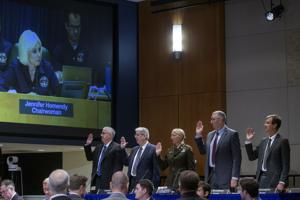The National Transportation Safety Board (NTSB) has commenced a pivotal fact-finding hearing, bringing to light critical concerns surrounding Washington’s congested airspace and the tragic midair collision earlier this year. This comprehensive inquiry aims to unravel the complexities that led to the fatal incident and address long-standing Washington airspace safety issues.
The collision, involving an Army helicopter and a commercial airliner, tragically claimed lives and ignited renewed scrutiny over military flights in densely populated civilian corridors. For years, aviators operating near Ronald Reagan National Airport have voiced apprehension regarding the frequency and operational practices of military helicopter traffic, particularly during nighttime hours.
During the extensive NTSB hearing, federal investigators heard testimonies from key officials representing Sikorsky Aircraft, the Federal Aviation Administration (FAA), and the U.S. Army. The proceedings delved deep into the circumstances of the crash, with a significant focus on the intricate challenges facing air traffic control concerns in the nation’s capital.
A recurring theme in the testimony was the widespread reliance on “visual separation” by pilots, where aircraft maintain distance based solely on eyesight. This practice, while common, was highlighted as particularly hazardous in Washington’s complex airspace, especially at night, and raised questions about whether onboard locator systems were active, impacting midair collision inquiry efforts.
Experts like Rick Dressler from Metro Aviation expressed profound discomfort with military units operating around Reagan airport, citing concerns about the relatively limited experience of some military pilots in the specific nuances of DC airspace. Dressler underscored what he termed “gross misunderstandings of the airspace,” pointing to a lack of “seasoning” among military aviators and their reduced participation in collaborative aviation meetings.
Beyond pilot practices, the hearing unveiled serious aviation safety reform concerns regarding FAA staffing levels. James Jarvis, a former evaluator of Reagan airport operations, recounted how a 2022 audit was halted due to 33 compliance issues, and he frequently raised alarms about insufficient air traffic controller numbers and support staff, leading to a “backslide” in facility performance after his reassignment.
In response to staffing critiques, the FAA asserted efforts to “supercharge” its hiring pipeline. However, the controller overseeing traffic during the collision that fateful night confirmed handling both airplanes and helicopters, despite the norm of a dedicated helicopter controller. A critical detail emerged: the helicopter crew missed a crucial instruction to “pass behind” the jet because their microphone key was pressed at that exact moment.
Aviation safety expert John Cox, a retired airline pilot, emphasized key questions surrounding the Army Black Hawk’s operations, including why it was above a 200-foot elevation limit and not closer to the Potomac’s east bank, further from landing aircraft. The broader fatal crash inquiry seeks not only to understand what transpired but to implement measures preventing future tragedies.
As the NTSB hearing continues its work, the collective hope is for robust accountability and meaningful reforms that address systemic vulnerabilities in airspace management and pilot training. This incident serves as a stark reminder of the continuous need for vigilance and adaptation in ensuring the utmost aviation safety within highly complex and vital air corridors.






Leave a Reply